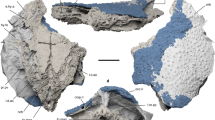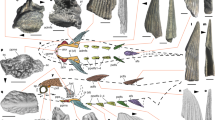Abstract
The marine leatherback turtle, Dermochelys coriacea (Testudines, Dermochelyidae), is the largest known extant reptile, reaching weights >680 kg. It has a cosmopolitan oceanic distribution, nesting in tropical climates but migrating widely into colder temperate and boreal waters1. Recent studies have shown that the leatherback has certain well developed thermoregulatory adaptations: vascular counter-current heat exchangers in the flippers, thick subcutaneous insulation beneath its leathery shell and effective inertial homoiothermy, if not endothermy2,3. Whether this ability to maintain a body temperature higher than the ambient is due to endogenous endothermy or thermal inertia remains unclear4,5. The skeleton of Dermochelys remains extensively cartilaginous even in adult animals6,7, which has been attributed to neoteny secondary to its highly pelagic habitat, based on the assumption that its skeleton resembled that of typical embryonic turtles8. However, up to now there have been no studies of the internal architecture of the leatherback appendicular skeleton. We report here that the chondro-osseous morphology of Dermochelys is unlike that of any other known extant turtle or reptile but is more similar to that of marine mammals, notably Cetacea (whales) and Sirenia (manatees).
This is a preview of subscription content, access via your institution
Access options
Subscribe to this journal
Receive 51 print issues and online access
$199.00 per year
only $3.90 per issue
Buy this article
- Purchase on Springer Link
- Instant access to full article PDF
Prices may be subject to local taxes which are calculated during checkout
Similar content being viewed by others
References
Pritchard, P. C. H. Catalog of American Amphibians and Reptiles, 238 (1980).
Frair, W., Ackman, R. G. & Mrosovsky, N. Science 177, 791 (1972).
Greer, A. E., Lazell, J. D. Jr & Wright, R. M. Nature 244, 181 (1973).
Neill, W. H. et al. Science 184, 1008 (1974).
McNab, B. K. & Auffenberg, W. Comp. Biochem. Physiol. 55A, 345 (1976).
Gervais, P. Mem. Nouv. Arch. Mus. nat. Hist., Paris 8, 199 (1872).
Dollo, L. Bull. Mus. R. Hist. nat. Belg. 5, 59 (1888).
Deraniyagala, P. E. P. Proc. zool. Soc. Lond. 68, 1057 (1930).
Haines, R. W. J. Anat. 72, 323 (1938).
Suzuki, H. K. Ann. N. Y. Acad. Sci. 109, 351 (1963).
Felts, W. J. L. & Spurrell, F. A. Am. J. Anat. 118, 103 (1966).
Fawcett, D. W. Am. J. Anat. 71, 271 (1942).
Haines, R. W. J. Anat. 75, 282 (1941); Biol. Rev. 17, 267 (1942); in Biology of the Reptilia Vol. 1 (eds Gans, C., Bellairs, A.d'A. & Parsons, T. S.) 81–115 (Academic, London, 1969).
Moodie, R. L. Am. J. Anat. 7, 443 (1908).
Enlow, D. H. & Brown, S. O. Tex. J. Sci. 9, 186 (1957).
Ricqles, A. J. de in Morphology and Biology of Reptiles (eds Bellairs, A.d'A. & Cox, C. B.) 123–150 (Academic, London, 1976).
Cope, E. D. Proc. Am. phil. Soc. 12, 422 (1872).
Ricqles, A. J. de Colloques int. Cent. nat. Rech. Sci. 218, 351 (1975).
Versaggi, C. S. Sci. Biol. J. 3, 305 (1977).
Meister, W. Anat. Rec. 143, 377 (1962).
Nopcsa, F. Anat. Anz. 56, 353 (1923).
Sickenberg, O. Palaeobiologica 4, 405 (1931).
Case, E. C. J. Morph. 14, 21 (1897).
Wieland, G. R. Am. J. Sci. 9, 413 (1900); 14, 95 (1902); 27, 101 (1909).
Romer, A. S. Osteology of the Reptiles (University of Chicago Press, Chicago, 1956).
Gaffney, E. S. Bull. Am. Mus. nat. Hist. 155, 387 (1975).
Wermuth, H. & Mertens, R. Tierreich 100, 1 (1977).
Frair, W. Herpetologica 35, 239 (1979).
Hay, O. P. Am. Nat. 32, 929 (1898).
Zangerl, R. Fieldiana, Geol. Mem. 3, 57 (1953).
McNab, B. K. Am. Nat. 112, 1 (1978).
Ricqles, A. J. de C. r. hebd. Séanc Acad. Sci., Paris 268D, 782 (1969); Evol. Theory 1, 51 (1974); in Morphology and Biology of Reptiles (eds Bellairs, A.d'A. & Cox, C. B.) 123–150 (Academic, London, 1976).
Ricqles, A. J. de Année biol. 18, 1 (1979).
Author information
Authors and Affiliations
Rights and permissions
About this article
Cite this article
Rhodin, A., Ogden, J. & Conlogue, G. Chondro-osseous morphology of Dermochelys coriacea, a marine reptile with mammalian skeletal features. Nature 290, 244–246 (1981). https://doi.org/10.1038/290244a0
Received:
Accepted:
Issue Date:
DOI: https://doi.org/10.1038/290244a0
Comments
By submitting a comment you agree to abide by our Terms and Community Guidelines. If you find something abusive or that does not comply with our terms or guidelines please flag it as inappropriate.



